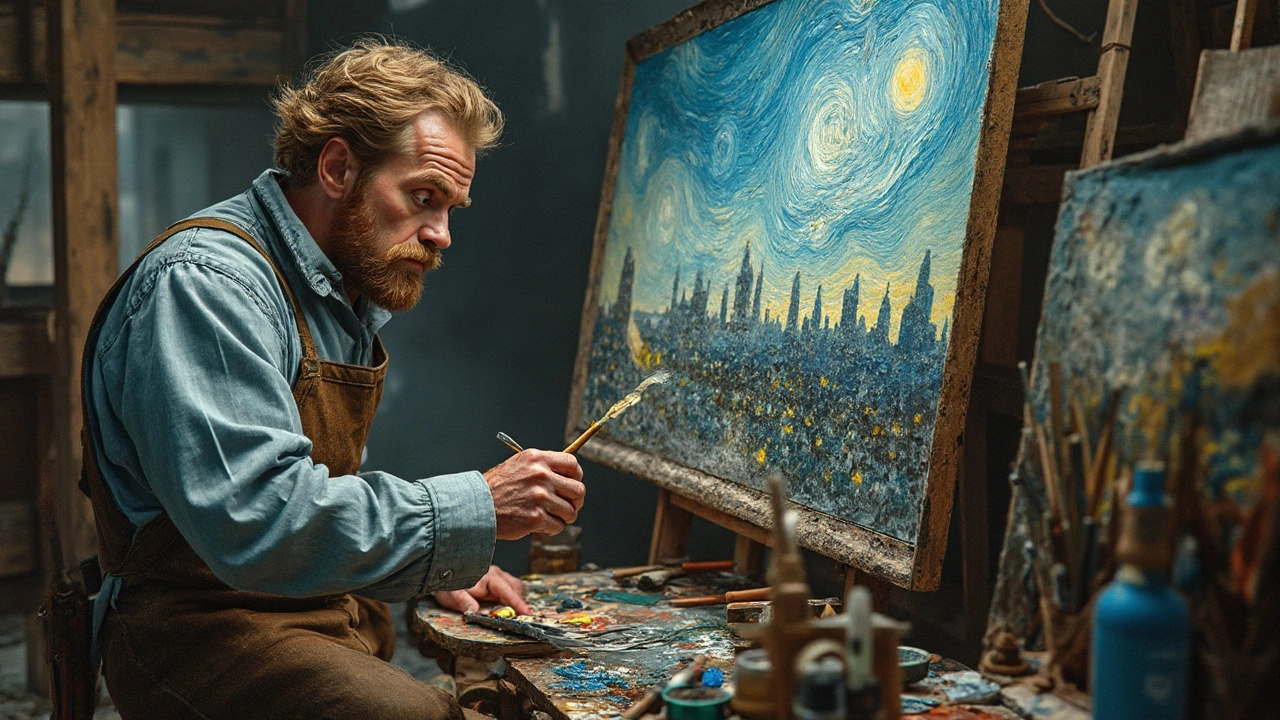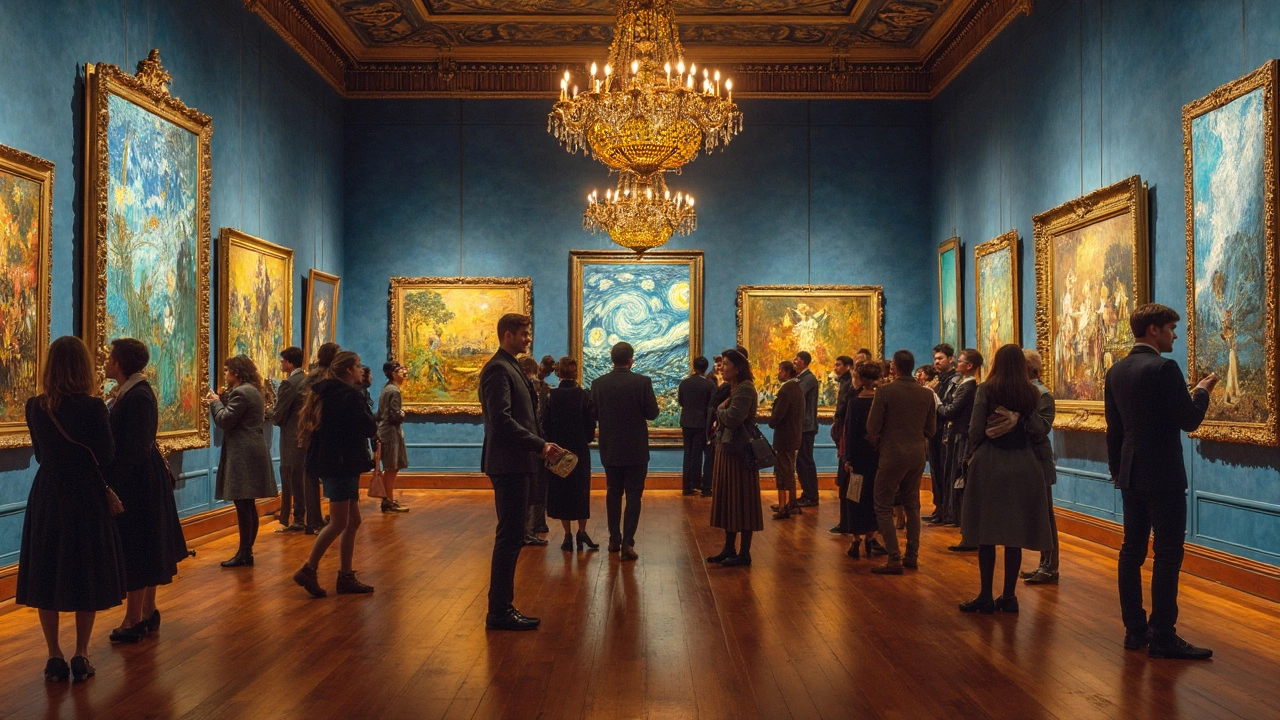When we think of Vincent van Gogh, images of swirling night skies and vibrant sunflowers often come to mind. Yet, here's a question that might stir a little healthy debate: Was Vincent van Gogh an abstract artist? At first glance, the swirls and bold strokes in his paintings suggest a touch of abstraction, but those forms are still very much recognizable.
Van Gogh’s work is special because it sits on the borderline. He played with color and form in ways that pull viewers into a realm that's neither fully abstract nor entirely realistic. His brushstrokes danced across the canvas, creating energetic, sometimes chaotic compositions. This balance made him a sort of bridge to what came after him, inspiring countless artists to explore abstraction further.
- Van Gogh's Artistic Style
- Abstract Elements in His Work
- Recognizable Forms and Subjects
- Impact on Future Artists
- The Debate on Abstraction
- Van Gogh's Legacy in Abstract Art
Van Gogh's Artistic Style
Vincent van Gogh is undoubtedly one of the most famous figures in the history of Western art. His artistic style is characterized by bold, dramatic colors and expressive, emotive brushwork. But what made him stand out was how he captured emotion in everyday settings—something that wasn't so common in his time.
Color and Emotion
Van Gogh had a unique ability to use color to express mood. Just think of his painting the 'Starry Night': it's not just the swirling blues and yellows; it's how those colors make you feel. He often exaggerated the hues to push an emotional response, departing from traditional realism. It's one of the traits that make people wonder if his works were tipping into the realm of abstract art.
Distinct Techniques
His technique also involved heavy and dynamic brush strokes. Van Gogh often worked with thick applications of paint, known as impasto. This technique gave his paintings texture, almost as if the canvas itself had a life force. For instance, 'The Potato Eaters' shows his mastery of this technique even in subdued color tones.
| Painting | Year | Technique |
|---|---|---|
| Starry Night | 1889 | Impasto |
| The Potato Eaters | 1885 | Dark palette, early impasto |
Beyond Post-Impressionism
While Van Gogh's work is classified as Post-Impressionism, his approach was quite different from that of others in the same category. He wasn't interested just in how light hit objects but more in how it told a story—taking the essence of what was seen for his compositions but amplifying the emotional impact. Even his friend and fellow artist Paul Gauguin noticed this divergence, writing about Van Gogh's 'adventurous spirit' in an era where conventions were rarely challenged.
Van Gogh's artistic style, with its vibrant colors and emotional depth, was foundational for future artists seeking to break free from realism. His influence on art history is undeniable, and his work continues to inspire debates about where realism ends and abstraction begins.
Abstract Elements in His Work
Vincent van Gogh's art is known for its intense and emotional use of color and swirling brush strokes. These aspects definitely point to abstract qualities in his work. Although Van Gogh didn't fit the strict definition of an abstract artist, his contributions to the art history cannon opened doors to abstract developments in the 20th century.
One clear example is "Starry Night", perhaps one of his most famous paintings. The way the sky twists and turns with rhythm suggests a world beyond what the eye can see and invites viewers to connect emotionally rather than intellectually. These visual elements create a sense of movement that's almost hypnotic. It's a blend of reality and imagination, offering a perfect example of where tangible landscapes meet abstract expression.
Apart from the dizzying skies, Van Gogh's thick, circular strokes were applied in a manner that gives physical texture to his paintings. This technique amplified the emotional impact and could sway the mood of a given piece. It showed an understanding of how painting techniques could evoke a visceral reaction. His work in "Wheatfield with Crows" similarly plays with perspective and depth, opting for expression over exact representation.
To cap things off, Van Gogh's use of color was groundbreaking. He applied color theory in unexpected ways, connecting warm and cool tones to provoke an emotional response in the viewer. While painting, he often broke from the natural palette, using contrasting colors side by side. This aspect tied him to later abstract artists who sought to show 'truth' beyond realistic appearances.
Though some might argue against pinning the abstract art label on Van Gogh, the elements are undeniably there, showcasing his diverse talent and revolutionary impact on the art world.
Recognizable Forms and Subjects
While Vincent van Gogh is famous for his expressive style, what's interesting is his ability to depict recognizable forms amidst the chaos of his brushstrokes. Whether it's a sunflower or a starry night, you can usually tell what you're looking at, even if it's swirling with color and energy.
Take "The Starry Night" for instance. The painting vividly portrays a night sky over the small town of Saint-Rémy-de-Provence. It's full of movement and strong color contrasts, yet viewers can clearly make out the crescent moon and the Orion constellation. This shows how Van Gogh brilliantly blended reality with his unique style.
Many of Van Gogh’s portraits, like his self-portraits or "The Potato Eaters," also highlight this recognizable approach. The people have exaggerated features but remain unmistakably human, capturing a rustic and emotional side of life. In discussing Van Gogh's ability to portray real subjects with artistic flair, the art critic Robert Hughes once remarked,
"No other artist was capable of translating such raw motion into form without losing the essence of what they truly depicted."
Why did Van Gogh stick to recognizable subjects? Some say it was his way of conveying deeper emotions or messages without getting too lost in abstraction. After all, keeping forms identifiable helped him connect with viewers on an emotional level, steering their eyes and guiding their emotional responses.
| Painting | Place Depicted | Year |
|---|---|---|
| The Starry Night | Saint-Rémy-de-Provence | 1889 |
| The Potato Eaters | Nuenen | 1885 |
| Sunflowers | Arles | 1888 |

Impact on Future Artists
Vincent van Gogh's influence on future generations of artists cannot be understated. Though he wasn't celebrated during his lifetime, his bold use of color and dynamic compositions paved the way for many movements in modern art.
Expressionism, a movement that emerged in the early 20th century, owes much to Van Gogh's emotionally charged canvases. Artists like Edvard Munch, famous for 'The Scream,' drew inspiration from Van Gogh's ability to convey deep emotion through seemingly chaotic brushstrokes.
The Fauvist artists also picked up Van Gogh's baton, embracing his vivid color palette. Henri Matisse and Andre Derain, key figures in Fauvism, admired how Van Gogh used color to express mood rather than just represent reality.
As the 20th century continued, Van Gogh's work inspired the development of abstract art itself. His disregard for traditional art norms encouraged artists like Wassily Kandinsky and Jackson Pollock to continue experimenting with form and color. Van Gogh demonstrated that art could be expressive without being literal, opening up new avenues for creative exploration.
Today, Vincent van Gogh continues to inspire. His post-impressionist paintings are not only studied but remain a benchmark of expressive potential. Art students and established artists alike find themselves returning to his work, trying to capture just a hint of his unorthodox magic.
| Artists Influenced by Van Gogh | Movement |
|---|---|
| Edvard Munch | Expressionism |
| Henri Matisse | Fauvism |
| Jackson Pollock | Abstract Expressionism |
The Debate on Abstraction
Vincent van Gogh's work has always been a hot topic when discussing the term abstract art. Some argue that the swirling skies of Starry Night and the vibrant motion of his Sunflowers hint at abstract tendencies. Yet, does that make him an abstract artist? It’s a question that both critics and fans have mulled over for ages.
Van Gogh never labeled himself as abstract. Growing as a painter during the late 19th century, most of his peers and the general art scene leaned heavily towards realism. But Van Gogh’s unique approach to color, form, and emotional expression started to push those boundaries a bit.
The Art World’s Take
Art historians often discuss whether Van Gogh’s influence paved the way for 20th-century abstract pioneers like Kandinsky and Mondrian. What’s fascinating is that even though Van Gogh’s works remain rooted in real-world objects—landscapes, people, flowers—they seem to carry a raw emotional abstraction.
Take for example the thick application of paint and intense colors he used. These techniques emphasize mood over realistic representation—something characteristic of later abstract works. It was as if Van Gogh painted emotions rather than scenes.
Where’s the Line?
Honestly, defining abstraction can be tricky, like asking where a rainbow starts and ends. Van Gogh didn’t entirely break away from recognizable forms, which is a hallmark of pure abstract art. But in pushing the emotional expressiveness in painting, he nudged ever closer to those abstract horizons.
In the end, though Van Gogh might not check all the boxes we associate with modern abstract art, his daring style sparked conversations that paved the way for what was to come. It’s his bridging of realism and abstraction that remains significant, inviting us to stop categorizing for a moment and just enjoy the art.
Van Gogh's Legacy in Abstract Art
So, how does Vincent van Gogh fit into the world of abstract art? To start with, his influence on modern art cannot be overstated. While he might not be the poster child for abstraction, his unique approach to color and emotion blazed a trail for abstract artists.
Many artists who embraced abstraction owe a nod to Van Gogh's innovative use of color. His vibrant and often wild color palettes signaled a departure from traditional techniques. By showing that color could express emotion, rather than just represent reality, he helped pave the way for abstract movements like Fauvism and Expressionism.
Influence on Mid-20th Century Artists
Moving into the mid-20th century, artists like Jackson Pollock and Mark Rothko advanced these ideas further. Though they are often considered giants of abstract art, the emotional intensity found in Van Gogh's work is a common thread that links them all. Pollock's chaotic splatters and Rothko's moody color fields both mirror Van Gogh's emotive approach, albeit in vastly different styles.
Additionally, consider the impact on Post-Impressionists and how his experimental brushwork led others to consider texture differently. Van Gogh showed that brushstrokes themselves could become part of the story the painting tells—an idea that resonates deeply with abstract painters even today.
The term 'abstract' might not fit him neatly, but Van Gogh's restless creativity and bold techniques contributed to the broader shift towards abstraction in art. So, while his work remains visually tied to the real world, his legacy lives on in the very fabric of abstract art.

